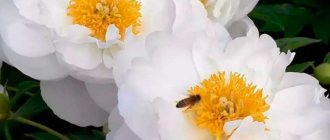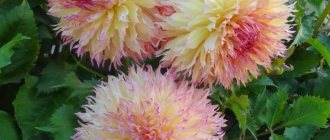History of selection
Peonies began to be grown as an ornamental plant in ancient China. Since then, breeders have developed about 5,000 new varieties with different characteristics and features. They differ in flowering time, bush shape and height, aroma and color. According to the existing classification, peonies are divided into three groups:
- Tree-like - perennials with woody shoots that do not die in winter, up to 2 m high.
- Herbaceous - shoots change annually.
- Ito hybrids are varieties created by crossing tree and herbaceous peonies; the stems die off in the fall.
The milky-flowered peony "Henry Boxtos" is an interspecific hybrid bred in 1955 in the USA. The originator of the variety is Bockstoce William S. Since then, “Henry Bockstoce” has spread throughout the world and a magnificent plant with giant red flowers can be seen in any garden.
"Henry Boxtos" - a hybrid with an average flowering period
Features and characteristics of the henry bockstoce variety
Henry Boxtoos is an interspecific Canadian hybrid with excellent visual characteristics. The tall, densely-leaved bush is decorated with large double buds of bright scarlet color. The buds have a spherical (less often pink) shape. The greens are dark green. The hybrid blooms in June and lasts for 3 weeks. Thanks to the beautiful shape of the leaves and lush greenery, the peony retains its decorative appearance throughout the season.
A characteristic feature of Henry Bockstoce is its strong stems that never fall or break from the wind. However, under the weight of the buds they can bend greatly. Therefore, to give the bush a vertical shape, some gardeners prefer to tie it up. A metal hoop on posts or ready-made plastic structures are used as a support for the garter.
Plant parameters:
- height – 80-100 cm;
- depth of the root system – up to 1 meter;
- bud diameter – up to 22 cm.
Important! The plant belongs to the third class of winter hardiness - it successfully overwinters when the air temperature drops to -40*C. Due to the similarity of the climate of Russia and Canada, Henry Bockstoce is successfully grown throughout the Russian Federation.
Suitable for single and group plantings, it makes beautiful combinations with roses, clematis and phlox. Scarlet peonies will decorate gazebos, lawns, and garden paths.
Description of peony Henry Boxtos
The perennial herbaceous plant has strong stems that can hold flowers without additional support. Peony leaves are twice trifoliate, pointed, light green with a yellow tint. Their length is from 20 to 45 cm. The roots are brown, thickened, spindle-shaped.
The peony bush "Henry Boxtos" is spreading, reaches a height of 1 m. At the top of the shoots, one bud is formed, which, after opening, turn into large, double, blood-red flowers. Their petals are dense, wide, with a satin sheen, and curved inward. The flower head is spherical in shape and reaches 20 cm in diameter. When blooming, the outer petals deviate outward from the center.
The abundant flowering of the Henry Boxtos peony is observed in early summer and is accompanied by a pleasant, strong aroma.
Plant in spring or fall
Peony Henry Boxtos:
- About the variety. The classic king of hybrids. Tall spreading bush 90 cm high. With powerful shoots topped with huge branches. The stems are stable, but during periods of high humidity they are not able to hold huge flowers, so they need staking.
- About flowers. The flowers are a rich dark red color with pink-shaped petals. The flowers are compact, densely packed, reaching 20-25 cm in diameter. The flowering is long and stable, the petals do not fly off the inflorescence. Looks great when cut and retains freshness for a long time. The leaf is an openwork decorative one that remains attractive until late autumn.
- About care. Prefers bright places and loose soil. Responsive to feeding. Propagated by dividing the bush and cuttings. It is not demanding in care, adapted to frost and short-term drought.
Channel “Garden of Voroshilova A.B.” recommends the hybrid Henry Boxtos for breeding.
Application in design
When choosing a place in the garden for the milky-flowered peony Henry Bockstoce, you should take into account the size of the bush and allocate sufficient area for it. The plants thrive in individual plantings and look impressive against the backdrop of a neatly trimmed, lush green lawn. Perennials look no less interesting against the background of conifers - spruce, juniper, thuja.
Peony blooms once - in the first half of summer
Landscape designers recommend combining the Henry Boxtos peony with clematis, phlox and roses. It is used in the design of mixborders created from continuously flowering perennials.
You should not place plants in flowerpots, even large ones. The root system needs sufficient space, and if it is limited, the Henry Boxtos peony feels depressed and stops blooming.
Important! Henry Boxtos peonies do not like acidic soil; soil with a neutral reaction is more suitable for them.
Pests and diseases
With proper care, the Henry Boxtos peony rarely gets sick, grows quickly and blooms profusely. To ensure that nothing interferes with the development of the plant, it is advisable to carry out preventive measures to protect against diseases and pests.
In autumn, peonies are treated with 1% Bordeaux mixture. To prevent diseases after pruning, the hemp and the ground around it can be sprayed with the same product at a concentration of 3%. For pests they use:
- "Lepidocide";
- "Fitoverm";
- "Bitoxibacillin";
- "Aktaru";
- "Fufanon."
Biological drugs cause less harm to human health
Insecticides of various compositions are effective in the fight against insects
Important! Before covering with mulch for the winter, paraffin granules are laid out around the perimeter of the bush to protect against mice, which readily feast on the roots of the crop.
Reproduction methods
The easiest and most effective way to propagate the Henry Boxtos peony is by dividing the rhizome. To carry it out you need to perform a number of sequential actions:
- At the end of August, cut off the above-ground shoots of the plant by a third.
- Carefully dig the rhizome out of the ground.
- Carefully free it from the soil by rinsing it with water.
- To make the roots elastic, lower them into the cellar for several hours.
- Prepare a sharp, disinfected knife.
- Cut the rhizome into pieces so that each has full roots and several buds.
- Treat the cut areas with a solution of potassium permanganate, crushed coal or wood ash.
Important! Peony rhizomes that are at least 5 years old are suitable for division.
There are other methods of reproduction that are used extremely rarely. The cutting method is very labor-intensive and ineffective. Reproduction of the Henry Boxtos peony by seeds leads to a deterioration in its species qualities, since it is a hybrid. A plant grown in this way blooms in the sixth year.
When propagating a peony by division, pay attention to the condition of the kidneys
Caring for ITO peonies
ITO peonies are long-lived compared to other species; they can live up to 18-20 years in one place.
Therefore, proper care is the key to their comfortable existence on your site. In fact, these luxurious flowers are not at all capricious - they are little susceptible to pests and diseases, resistant to weather vicissitudes, heat- and frost-resistant. Caring for them is similar to that for ordinary peonies.
Peonies - planting and care, all work by month Caring for peonies - when and what to do so that peonies bloom magnificently.
ITO hybrids do not need support; their bush is able to “support” itself.
Watering ITO peonies should be regular (especially for young seedlings planted in spring), but not excessive - you remember that these plants do not tolerate waterlogging and stagnation of water. Peonies need plenty of water only during severe drought. The need for watering can be checked by the condition of the top layer of soil - it should dry out slightly. On average, an adult plant needs about 15 liters of water per watering. It is better to water ITO peonies without active sun - in the evening.
After each watering, you need to carefully loosen the soil around the plant, which will ensure regular access of oxygen to the roots and lead to lush and abundant flowering. Simultaneously with loosening, weeds are removed. Also, to prevent moisture evaporation, the soil in the tree trunk circle should be mulched.
It is important not to overdo it when feeding ITO hybrids. They begin to fertilize these flowers from the third year - at the beginning of the season they apply nitrogen fertilizers, and at the end of flowering - potassium-phosphorus fertilizers, which promote the formation of buds and allow the peony to restore vitality
If the soil on your site in terms of acidity is not ideal for ITO peonies, do not forget to add dolomite flour or ash under the bush from time to time.
Ash - what kind of fertilizer is it, and how to use it correctly Ash is not just a fireproof residue after combustion, but also a valuable microfertilizer. Our material contains everything about how ash is useful for plants, how to use ash as a fertilizer, how to dilute ash for feeding, what spraying with an ash solution is...
In the fall, with the onset of serious frosts (much later than for herbaceous peonies), in dry weather the stems of ITO hybrids are cut off at ground level. Typically this period occurs in mid to late November.
Young plants can be insulated with spruce branches during the winter dormancy period; adult plants of ITO-peonies are quite winter-hardy and usually do not need such shelter.
As you can see, placing ITO peonies on your property will not be difficult. With relatively little labor, these magnificent flowers will delight you with their bright colors for a long time.
Planting and care
The optimal time for planting Henry Boxtos peonies is the end of August or the first ten days of September. At this time, it is convenient to dig up and divide the rhizome into “divisions”. Planting at the end of spring is acceptable, but in this case flowering will occur only in the next season.
For perennials, choose a sunny place, sheltered from northern winds. The soil should be loose, well-drained, with a neutral reaction. Peonies tolerate swampy soil and excess moisture worse than its lack. You should not plant the peony “Henry Boxtos” in low parts of the site or near structures where drifts are possible in winter and stagnation of water in spring after the snow melts.
As planting material, select “cuts” with 2-3 buds without damage, rot or cavities.
Important! Choosing a rhizome that is too large can cause the plant to refuse to flower after a few years.
To prepare for planting, the Henry Boxtos peony is dipped in a solution of potassium permanganate for 1 hour, after which it is powdered with ash or coal. If planting is delayed for some time, to reliably preserve the rhizome, it is wrapped in damp moss and craft paper.
When planting plants, adhere to the following algorithm:
- Dig a hole 60x60x60 cm.
- Place two buckets of rotted cow manure in the bottom.
- Pour 3 buckets of a mixture of garden soil, compost and ash on top.
- Place the “delenki” in the center of the planting hole so that the buds are at least 3 cm above the surface.
- Fill in the rhizomes and compact the soil a little.
- Water and mulch the soil.
Important! If the buds are not deepened correctly, the Henry Boxtos peony does not bloom.
Pomegranate peonies “Henry Boxtos” look very advantageous next to white and pink varieties
Subtleties of landing
Landing is performed according to the following algorithm:
- Dig a cube-shaped planting hole with an edge of 60 or 90 cm, depending on the size of the seedling.
- Disinfect the pit with potassium permanganate. The solution is prepared at the rate of 5 grams of potassium permanganate per 10 liters of water. Disinfection is necessary to neutralize pests and pathogenic microorganisms that can harm the plant at an early stage of the growing season.
- Place a 10 cm “nutrient cushion” on the bottom, consisting of a mixture of peat and humus. There should not be too much peat, because... it acidifies the soil.
- Place the seedling in the hole so that the lower bud is 3-5 cm behind the ground level.
- Fill the soil, carefully filling the voids between the roots and tamp lightly.
- Within a radius of 50 cm from the bush, screw up a small earthen mound 5-10 cm high, then water the plant generously at the root.
Despite the fact that Henry Boxtos perfectly adapts to any climate and growing conditions, the closest attention should be paid to the choice of site and planting time. In the future, this will fundamentally affect the quality of flowering.
Selection of location and soil
Peonies love spacious and well-lit areas. However, a long stay in the summer sun can lead to burns and petals falling off. Therefore, the best option would be an open area, part of the day in partial shade.
Other criteria for placing a flower bed:
- the length of a sunny day is at least 12 hours;
- the nearest buildings are at a distance of at least 2 meters;
- absence of competitive plants with a branched root system;
- groundwater does not approach the ground closer than 1.5 meters;
- The area is protected from gusty winds.
The soil for Henry Bockstoce should be loose and nutritious. Optimal pH level = 6.5.
Information! You can deoxidize the soil by liming. For 1 sq.m. 150-500 grams of slaked lime are added to the plot.
When is the best time to plant?
The best time to plant peonies is at the end of summer - beginning of autumn. At the end of the season, the plant redirects its forces to the growth of the root system, which has a beneficial effect on rooting. In early spring, rooted peonies begin to grow rapidly.
However, seedlings usually go on sale in March-April. For successful autumn planting, it must be prepared accordingly:
- dive into a large diameter pot with a slightly acidic substrate;
- place the pot in a cool, dark room;
- water moderately until the first buds peck;
- after the buds appear, place the flower on the windowsill;
- care for the plant according to the classical scheme: watering, loosening, applying complex fertilizing once a month.
Features of cultivation
Peony "Henry Boxtos" is an unpretentious plant that does not require special care. For its growth and development, it is necessary to water, fertilize, loosen and mulch the soil in a timely manner.
The perennial is moistened as needed, maintaining the soil at medium moisture. Watering of young plants that are at the stage of rooting and beginning of the growing season is monitored more carefully. Despite the ability of the Henry Boxtos peony to survive drought, you should not allow the soil to dry out. In hot weather, about 2 buckets of clean, settled water are poured under an adult plant in the evening.
Weeding is especially necessary during the first time after planting. Weeds are removed, and the soil around the Henry Boxtos peony is carefully loosened without damaging the roots located in the top layer. Immediately after loosening the soil, mulch it to slow down the drying process. For this purpose, dry grass, leaves and straw are used.
The plant needs periodic feeding, thanks to which it actively develops and blooms profusely. Both organic and mineral fertilizers are used. Phosphorus-potassium fertilizing is used twice - during budding and immediately after flowering.
Aftercare
Henry Boxtos peonies do not require complex care. It is enough to carry out basic agrotechnical measures:
- In summer, regular but moderate watering is needed. Especially during flowering, the plant should not dry out.
- It is necessary to weed around the peony and mulch the soil so that it remains loose.
- For lush flowering, Henry Boxtos is fed with complex mineral fertilizers in April. After flowering, only potassium and phosphorus are used.
In addition, peonies need timely autumn pruning and protection from pests and diseases.
Preparing for winter
The hybrid peony variety Henry Boxtos is a herbaceous species, so pruning must be carried out. If everything is done correctly, the plantings will delight you with lush flowering next year. The main mistake that novice gardeners make is cutting stems in early autumn. Because of this, the plant does not receive enough nutrients. It is thanks to the green leaves that the root is nourished and fully prepared for winter. The signal to begin work is the first frost, when the foliage droops.
In the fall, Henry Boxtos needs to be fed 14-15 days before persistent cold weather. You can carry out this procedure at the end of August. Phosphorus-potassium fertilizers are applied - monopotassium phosphate (1 tablespoon per 10 liters of water), superphosphate (50 g per 1 sq. m).
Advice! If it rains, fertilizers are given in dry form, scattered around the periphery of the bush. When there is no precipitation, it is better to apply liquid fertilizer.
The stems are not cut too low, leaving stumps 3-5 cm high. They work with a clean tool, wiping it after each bush. All cut foliage is removed from the flowerbed and burned or taken out of the area. After all the preparatory work, the peony is mulched with compost or peat. In the Northern regions, it is advisable to cover the plants of the first year of planting with a 15 cm layer of mulch.
Protection from diseases and pests
According to expert reviews and species descriptions, the Henry Bockstoce peony is resistant to diseases and pest damage. With incorrect agricultural practices and unfavorable environmental conditions, there is a risk of a number of diseases:
- gray rot is a fungal disease that affects shoots in spring or autumn, which leads to their drying out;
- root rot - the appearance of a white coating on rhizomes that rot and the entire plant dies;
- rust - brown spots on leaves with a dark border and swellings with fungal spores on the back side;
- mosaics are a viral disease that manifests itself in the form of a marble pattern on leaf plates.
To combat pathologies, the Henry Boxtos peony is treated with fungicides three times a season. For prevention purposes, you should use a clean, disinfected tool for cutting shoots, remove wilted leaves, buds and stems, and if the damage is significant, dispose of the entire plant.
Some insects cause significant damage to Henry Boxtos peonies. Among them:
- aphids - located on the leaves in groups, eat the buds, suck out the juice, which leads to wilting; insecticides are used to combat them;
- the bronze beetle is a bright beetle with a golden color that eats the entire flower; the most effective methods of destruction are manual collection of pests or the application of Medvetox or Thunder under the bush;
- root-knot nematodes are microscopic pest worms that attack the roots; such a plant must be dug up, burned, and the hole treated with a solution of 1% formaldehyde.
Diseases, pests and ways to combat them
The plant has strong immunity, but if there are unfavorable climatic factors or violation of the rules of care, there is a risk of developing rust, ring mosaic or gray rot. To avoid this, fungicides are used.
As diseases develop, peony leaves become stained
Peony Boxtos is a popular ornamental plant that can become a real decoration of the garden. To achieve excellent results in its cultivation, you need to properly care for the crop.
Preparing for winter
Henry Boxtos peonies are frost-resistant, tolerate temperature changes well and most often do not require additional shelter for the winter. To prepare the plant, after the first autumn frosts, the drooping stems are cut off, leaving no more than 3 cm. The shoots are removed from the site and burned to prevent the spread of spores and fungi.
In regions with a harsh climate and little snow in winters, it is worth mulching the pruned Henry Boxtos peony bush with dry sawdust, leaf litter, humus, loose compost, or using a breathable covering material for this purpose. If necessary, in winter the peony is additionally covered with snow.
Important! With the onset of spring, the covering material is removed and the mulch is raked away from the shoots to prevent the buds from rotting.
How to care?
Henry Bockstoce has its own care features that need to be taken into account when cultivating it:
- In the first 2 years of cultivation, the plant is not allowed to flower. To do this, all buds are removed at the tying stage. This system stimulates the growth of the root system and allows you to obtain the largest possible buds, starting from the 3rd year.
- In late autumn, after lodging of the bush, its entire above-ground part is cut off to 5 cm of “stumps”. This improves the wintering of the plant.
- As additional shelter for the winter, the pruned plant is mulched with a thick layer of sawdust or straw.
- Throughout the season, weeds are carefully removed and the soil is loosened to a depth of 5-10 cm. It is necessary to prevent the formation of a dense earthen crust. Loosening is especially important between waterings.
Watering
Peony prefers moderately moist soil. Drying of the substrate leads to withering of the plants (during flowering, the bud may fall off). At the same time, waterlogging of the soil becomes an activator of fungi, mold and root rot.
Therefore, when watering, you should adhere to the following rules:
- water early in the morning or late in the evening;
- avoid both drying out of the soil and stagnation of water in the flowerbed;
- try to prevent water from getting on the green parts of the plants;
- use warm water for irrigation;
- Pour 2-3 buckets of water under each bush.
Important! The rate and frequency of watering depend on the weather and soil composition. During drought, peonies are watered more often than in normal weather, on loose sandy soils - more abundantly than on heavy loams.
Top dressing
In March-April, to stimulate growth, peonies are fed with a weak solution of potassium permanganate (concentration - 2-3 grams per bucket of water). 5 liters of solution are poured under each bush. 14 days after the first feeding, nitrophoska is added to the soil at the rate of 2 grams per 0.5 liter per plant.
Instead of nitrophoska, you can use a nutrient mixture:
- Dilute 1 kg of mullein in 10 liters of water;
- add 40 grams of superphosphate and 20 grams of potassium sulfate;
- Apply 1 liter of mixture to each plant.
Important! Peonies definitely need to be fed 2 weeks after flowering. This is necessary to restore the strength of the plants before wintering. 15 grams of potassium and phosphorus are added to each bush.
Protection from diseases and pests
Peony Henry Bockstoce is most prone to diseases:
- Gray rot. It attacks leaves and stems in late spring or early autumn. Treatment consists of removing damaged parts of plants, limiting nitrogen fertilizers and alternately treating with foundationazole and oxychloride.
- Root rot. Manifests itself in blackening of stems and wilting. For treatment, foundationazole and the drug “Hom” are used. In most cases, the affected bush must be destroyed.
- Rust. A characteristic symptom is the appearance of orange-brown spots on the leaves. The affected leaves are torn off and burned, the remaining ones are sprayed with fungicides.
- Ring mosaic virus. The main symptom is the formation of unevenly colored rings and stripes on the leaves. The cause of the disease is most often pruning with a dirty tool or the spread of aphids.
Of the pests, ants and nematodes cause the greatest trouble to the gardener. The ants themselves do not harm peonies, but they can provoke the appearance of aphids. You can get rid of ants by spraying the flower bed with Fufanol. The root-knot nematode is a much more dangerous pest that can destroy the entire root system of a plant. There are no specific measures to combat it. Therefore, in case of damage, the bush must be dug up and burned.
Reproduction
Most often, "Bartzella" reproduces through division of the rhizome. This procedure can only be carried out with adult flowers over three years old.
There is nothing complicated in this process, but all Ito hybrids have a lower part that looks more like a tree than a flower, and therefore their root is very strong. When dividing it, you may well have to take a saw.
In addition, when dividing the root there is a fairly high risk of destroying the plant. Therefore, only people with experience should do this. It’s better to practice on something not so expensive.
Here's how the reproduction process occurs:
- First, thoroughly water the ground around the bush;
- then you can start digging, you can dig safely - peonies have a very developed root system that cannot be damaged;
- shake off excess soil;
- then cut the bush into 2 parts (in some cases into 3), so that each of them has several buds of its own;
- after this, you need to sprinkle the cut areas with charcoal, leaving them for some time in a dark place so that the charcoal dries;
- after this, the bushes are planted according to standard instructions.
If you do everything correctly, then soon you will have not one, but 2 peony bushes on your site.
In addition to division, peonies are sometimes propagated by cuttings. This is done very rarely, but this possibility is still worth mentioning.
Description and features
The flowers are a lush perennial plant with dense spreading roots and fleshy buds. The height of the stem usually ranges from 80 to 100 cm. The plant has the appearance of a shrub with dissected foliage. The flower has an average diameter of about 20 cm, is single, double, and resembles a ball in shape. In structure, it has a central non-opening bud of petals, moving from small to larger.
By color, peonies of the Henry Bockstoce variety are:
- white;
- pink;
- red.
Rarely, but yellow and cream shades come across.
Gardeners love peonies because they begin to bloom in early to mid-June, when the sun begins to shine. But their main advantage is tolerance to drought, resistance to diseases, the flowers can withstand January frosts well, and they coexist without problems in any composition or alone.
The plant loves to bathe in the sun, but is tolerant of life in a little shade.
Landing
Tomato “Russian apple tree”: description of the variety, features of cultivation and care
Planting peonies follows a simple, familiar pattern and does not require much effort from the gardener.
Selecting a location
Choose a good place to plant the peony; it will like a windless area with good sunlight. It is not recommended to plant Henry Boxtos near walls and high, dense fences.
Deadlines
It is believed that it is best to plant peonies in August-September, after the bush has been dug up and divided, selecting high-quality roots. But usually seedlings go on sale only by February. I don’t want to wait for autumn at all, so you can plant peonies in the spring, the main thing is to do this following the planting recommendations.
Of course, so that the first flowers appear by summer, it is preferable to wait until autumn.
Soil requirements
In order for peonies to take root, pay attention to the soil. Choose loose, moderately dry soil with good drainage properties. Peonies do not like large amounts of moisture, but they are not ready to exist in lack of moisture.
Peonies do not like large amounts of moisture, but they are not ready to live in a shortage.
Planting scheme
To plant a seedling, dig a hole 90 x 90 x 90 cm a month before planting. Fertilize the soil with peat, humus and ash. If you fertilize the soil well during planting, then the necessary elements will be sufficient for the next year, or even two. In order for the plant to take root and bloom, place the seedling no higher and no lower than 3-5 cm from ground level.
For the first year, gardeners recommend removing the buds so that the flower can gain strength and develop a strong root system.
Caring for peonies consists of simple and familiar actions: weeding, loosening, watering, fertilizing.
Watering
Water the peony bush infrequently, only as needed, to maintain average soil moisture. In the first few years of the flowers' life, do not allow the soil to dry out, despite the fact that the plant can survive drought; do not take risks until Henry Boxtos takes root firmly in the new place.
Loosening and weeding
Weeding the area with peonies also occurs as needed.
And loosening, being careful and careful not to catch the delicate root system. After loosening, mulch with dry grass.
Top dressing
The flower bush needs feeding in the first year. Organic or mineral fertilizers are suitable for these purposes. To ensure the plant has many years of life, as soon as the buds form on it, it is necessary to feed the soil with phosphorus-potassium concentrate. It is recommended to repeat the procedure after flowering.
Trimming
Peonies are pruned in the fall, in preparation for winter. They begin the procedure after lodging of the shoots. The plant is pruned to a small stump.
There is no need to insulate the flowers after the event; they feel great under a layer of snow.
Growing a flower: how to plant it correctly in open ground
In order for the plant to develop normally, certain recommendations must be followed when planting.
Planting with root cuttings
The crop is most often propagated by root cuttings. They can be obtained by dividing the bush or buying ready-made planting material. In the second case, you should carefully study its quality
It is important that there are no traces of rot or mold on the root cutting. Small roots should have a white tint. Important! It is recommended to plant the crop in April or September
Important! It is recommended to plant the crop in April or September
Important! It is recommended to plant the crop in April or September
Selecting a location
To grow Miss America peony, it is recommended to choose a sunny area. A slightly shaded area is also acceptable. If there is insufficient lighting, the buds will turn out too small
Proper air circulation is of no small importance. It helps prevent the development of diseases. For your information! It is strictly forbidden to plant peonies in close proximity to other bushes or trees.
For your information! It is strictly forbidden to plant peonies in close proximity to other bushes or trees.
The flower is characterized by a powerful root system, which requires a lot of space underground
For your information! It is strictly forbidden to plant peonies in close proximity to other bushes or trees. The flower is characterized by a powerful root system, which requires a lot of space underground.
Experienced gardeners plant peonies away from buildings. The heat that comes from the walls has a negative effect on the state of the culture. The optimal interval should be 2 m.
Peonies bloom well in a sunny area
How to prepare the soil and flower for planting
This culture develops best in cultivated soil. Loam is perfect. You should not plant peonies in areas with high groundwater. It is recommended to mix clay and humus into sandy soil. When planting in clay soil, it is worth adding compost, sand and peat.
Soil with low pH parameters is excellent for this variety. If this indicator is elevated, gardeners advise adding a small amount of lime. Peat soil is not suitable for peonies.
In order for the plant to adapt well to new conditions, the hole must be filled 2/3 with garden soil, peat, sand and humus. It is also worth adding 1 kg of wood ash and 300 g of superphosphate.
Step by step landing procedure
To plant a Miss America peony, you must follow these steps:
- Dig a hole measuring 60 cm.
- Loosen the bottom.
- Place drainage at the bottom.
- Fill the hole with a mixture based on earth and humus.
- Sprinkle a small layer of soil.
- Plant a bush.
- Cover the hole with soil.
- Lightly compact the soil around the plant.
- Water the peony generously.
Planting by seeds
The seed method of propagating peonies is used quite rarely. Since the crop is a hybrid variety, this method does not allow preserving the varietal characteristics of the plant. It is usually used by breeders to develop new crops.
Use Cases
This attractive, bright plant looks great both in compositions and alone. Peonies feel great in the flowerbed and get along in bright mixborders. Usually they prefer to plant the variety against the backdrop of a lush lawn or near a small gazebo; it looks very attractive.
An equally attractive combination can rightfully be called a composition of peonies and conifers: the lush buds of Henry Boxtos look great next to thujas, junipers and dwarf pine.
Bloom
Peony Sorbet (Paeonia Sorbet) - growing in the garden
The Henry Boxtos peony blooms in the third year after planting. It is recommended to pick off the first buds: the bushes must first become well established. Peony flowers are large, double, garnet-red in color. The buds begin to open at the end of May. Flowering lasts 15-20 days.
When the buds begin to crumble and dry out, they are removed from the bush. This will make the plants look more decorative. It happens that peonies do not bloom. This happens under the following circumstances:
- the bushes are planted in a shady, damp place;
- the root collar is too deep;
- there is an excess of nitrogen in the soil, which promotes the growth of green mass, but prevents flowering;
- Last year, immediately after flowering, the stems were cut off at the root. In this case, future flower buds do not have time to develop;
- plants are affected by diseases and pests.
By correcting mistakes in care, the gardener will be able to admire the flowering peonies for many years.
Henry Bostox's Blooming Bud
Landing Features
Peonies can grow in one place for up to 10 years, so it is necessary to choose the right planting site.
When is the best time to plant peonies? Flower seedlings should be planted in open ground in spring or autumn. The planting site should be well lit and not retain large amounts of moisture.
The plant has high vitality and tolerates frosts, lack or excess of moisture and other unfavorable environmental factors. Peony Boxtos is designed in such a way that when the shoots die, underground renewal buds on the root system are activated and the plant comes to life again.
The only thing that a plant of this variety cannot tolerate is peat. Peonies prefer soil with a neutral acid-base reaction, and peat leads to acidification.
It is also important to be careful when using mineral fertilizers, as they also lead to increased soil acidity
Flowers grow well in loamy soil with good draining properties. In the selected area, you should dig a hole 60 cm deep and 65-70 cm in diameter. In this case, the depth of planting the flower will be much less. At the bottom of the recess you need to place a drainage layer of crushed brick or expanded clay.
On top of the drainage layer it is necessary to place a mixture of fertile soil with organic components. The pit should be filled 2/3 full with the nutrient mixture. In the remaining space you need to place a young seedling with a light root system and large renewal buds.
In the planting hole, it is necessary to straighten the roots of the seedling and sprinkle them with soil, without additives, in a layer of 7 cm. After 1-2 years, the herbaceous peony will begin to actively bloom. If after this period of time the plant begins to form buds, the plant should be transplanted to a new location. Perhaps for the first time mistakes were made in the choice of location or soil composition.
Planting peonies does not take much time, but if done incorrectly, even the best care will not help to obtain abundant flowering.
Basic principles of caring for flower bushes:
- timely watering and loosening of the soil;
- fertilizer;
- elimination of weeds;
- pruning
During the entire warm season, it is necessary to remove all weeds located in the hole with the plant. The greatest harm to the plant comes from weeds growing in the center of the flower bush.
The peculiarity of this plant is the fact that as it grows, the root system grows upward. In order for the entire rhizome to receive moisture and nutrition, each time you loosen it, you should rake the soil towards the center of the bush. The loosening itself must be done superficially so as not to damage the roots.
Loosening the soil is required after each watering or precipitation. The procedure opens air access to the root system and prevents the appearance of a dense earthen crust.
Flowers should be fertilized immediately after planting, while other varieties need fertilizer only after a few years. This is due to the fact that this variety has weak roots in young shoots and they require additional nutrition for full rooting.
In spring, the plant requires fertilizing with a solution of water and cow manure. In mid-summer, experts recommend introducing potassium-phosphorus fertilizers into the soil, this helps the plant form strong renewal buds.
The rhizome of an adult plant can grow up to a meter in depth. This is what helps the plant to withstand all unfavorable conditions. To ensure that large roots evenly receive moisture and nutrients, at least 20 liters of liquid should be poured onto one bush.
Before and after flowering, it is enough to water the plant 1-2 times a week. During the flowering period, watering should be done more often, but without increasing the amount of moisture.
Before the onset of cold weather, it is necessary to prune flower bushes. The plant should be trimmed before the first frost, leaving only five-centimeter stumps. Cutting stems earlier will weaken the flowers and increase the likelihood that they will not survive the winter. No additional preparation for winter is required.
With proper care, the plant retains its decorative appearance until the end of autumn. The foliage of the Henry Boxtos peony changes the color of the leaves three times per season, from green to yellow and then to bronze, which makes the flowers more decorative. In landscape design, flowers look great either alone or in combination with low-growing plants.











